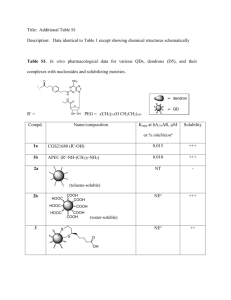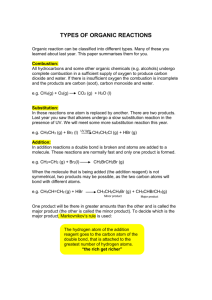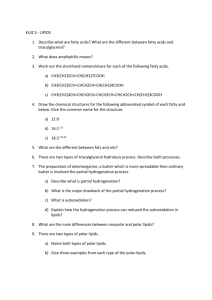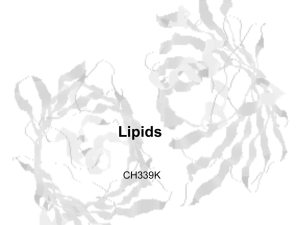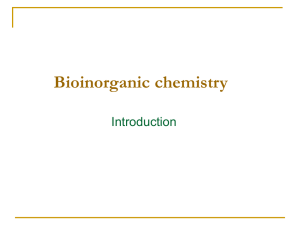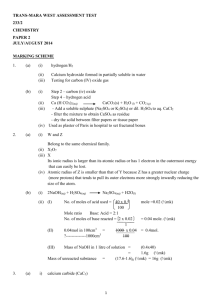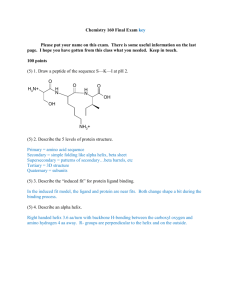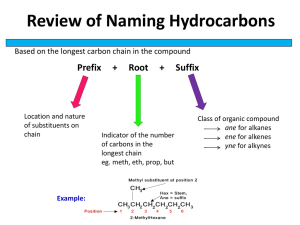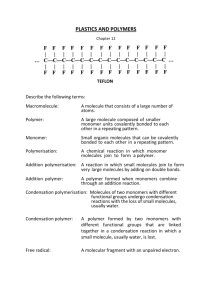Key - Kendriya Vidyalaya IIT Chennai
advertisement
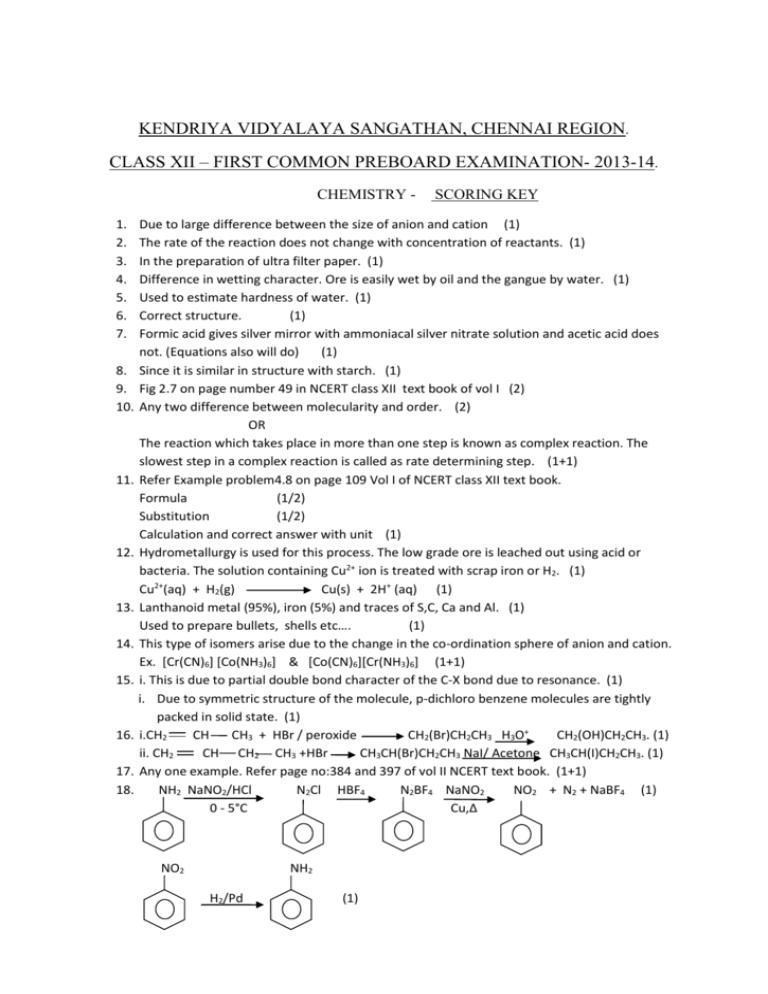
KENDRIYA VIDYALAYA SANGATHAN, CHENNAI REGION. CLASS XII – FIRST COMMON PREBOARD EXAMINATION- 2013-14. CHEMISTRY 1. 2. 3. 4. 5. 6. 7. SCORING KEY Due to large difference between the size of anion and cation (1) The rate of the reaction does not change with concentration of reactants. (1) In the preparation of ultra filter paper. (1) Difference in wetting character. Ore is easily wet by oil and the gangue by water. (1) Used to estimate hardness of water. (1) Correct structure. (1) Formic acid gives silver mirror with ammoniacal silver nitrate solution and acetic acid does not. (Equations also will do) (1) 8. Since it is similar in structure with starch. (1) 9. Fig 2.7 on page number 49 in NCERT class XII text book of vol I (2) 10. Any two difference between molecularity and order. (2) OR The reaction which takes place in more than one step is known as complex reaction. The slowest step in a complex reaction is called as rate determining step. (1+1) 11. Refer Example problem4.8 on page 109 Vol I of NCERT class XII text book. Formula (1/2) Substitution (1/2) Calculation and correct answer with unit (1) 12. Hydrometallurgy is used for this process. The low grade ore is leached out using acid or bacteria. The solution containing Cu2+ ion is treated with scrap iron or H2. (1) Cu2+(aq) + H2(g) Cu(s) + 2H+ (aq) (1) 13. Lanthanoid metal (95%), iron (5%) and traces of S,C, Ca and Al. (1) Used to prepare bullets, shells etc…. (1) 14. This type of isomers arise due to the change in the co-ordination sphere of anion and cation. Ex. [Cr(CN)6] [Co(NH3)6] & [Co(CN)6][Cr(NH3)6] (1+1) 15. i. This is due to partial double bond character of the C-X bond due to resonance. (1) i. Due to symmetric structure of the molecule, p-dichloro benzene molecules are tightly packed in solid state. (1) 16. i.CH2 CH CH3 + HBr / peroxide CH2(Br)CH2CH3 H3O+ CH2(OH)CH2CH3. (1) ii. CH2 CH CH2 CH3 +HBr CH3CH(Br)CH2CH3 NaI/ Acetone CH3CH(I)CH2CH3. (1) 17. Any one example. Refer page no:384 and 397 of vol II NCERT text book. (1+1) 18. NH2 NaNO2/HCl N2Cl HBF4 N2BF4 NaNO2 NO2 + N2 + NaBF4 (1) 0 - 5°C Cu,Δ NO2 NH2 H2/Pd (1) 19. Refer example problem 1.5 on page NO:21of vol I NCERT text. (2) OR a = 4r/√3 =2 *245 x 10-10/√3 = 283 x 10-10 (1) d= MxZ/NAxa3 = 52x2/ 6.02 x 1023x(283 x 10-10)3 = 7.625 g/cm3. (1) 20. ΔTf =i Kf w* 1000/M x wt of solvent W = ΔTf M * wt of sol/i Kf * 1000 (1) = 7.5 x 58.5 x 65/ 1.87 x 1.86 x 1000 = 8.2 g (1) 21. Correct definitions (1+1+1) Refer page no 141&142 of Vol I NCERT text. 22. Correct structures (1+1+1) Refer page No : 205, 200 & 179 of Vol-I of NCERT text. 23. i. They have unpaired electrons in the d orbitals which can undergo d-d transition. ii.Mn can form +7 oxidation state with oxygen since oxygen can form multiple bond which can stabilize the highest oxidation state. Fluorine cannot form multiple bond with Mn. (1) iii.Though Cu has completely filled d10configuration in its +1 oxidation state, The high hydration enthalpy of Cu2+accounts for the + ve value. (1) 24. i. CH2 CH3 + H3O+ OR ii. ii. CH2=CH2 CH2=CH-CH3 H3O+ Product H3O+ Product Product (1) (1) (1) 25. Tertiary structure (1) Globular protein is soluble in water and fibrous protein does not. (1) Globular- Egg albumin, fibrous – Keratin (or any other). (1) 26. i. Nylon6 – Caprolactum (or) 6-amino hexanoic acid; NH2CH2(CH2)4 COOH. (1) i. Phenyl ethene; C6H5-CH CH2. (1) ii. 2- Chloro-1,3-butadiene; CH2 C(Cl)CH CH2. (1) 27. i. Dettol is an antiseptic. (1) ii. Tincture of Iodine or any other. (1) iii.Concern for fellow being or any other. (1) 28. i. Ecell = E°cell – 0.0591 log [Al3+]2/[Cu2+]3 (1) 6 = 0.34 – (-1.66) = 2.0v (1) -3 2 = 2 – 0.00985 log (10 ) / (10-2)3 = 2v (1) ii.Anode – Zn container; Cathode- carbon rod Zn2+ + 2e. Anode reaction = Zn Cathode reaction= MnO2 + NH4+ + e- (1) (1/2) MnO(OH) + NH3. (1/2) OR i. Molar conductance of strong electrolytes increases with increase in dilution due to decrease in attractive force between the ions. (1) Molar conductance of weak electrolyte first increases steadily with increase in dilution and then increases deeply after certain dilution due to formation of new ions after certain dilution. (1) Graph on page no:79 of vol – I of NCERT text book. (1) ii. Refer example problem 3.5 on page NO: 78 of Vol – I of NCERT text. (2) 29. i. a.NH3,PH3,AsH3,SbH3,BiH3 (1) b.H2Te, H2Se, H2S, H2O (1) c. HClO, HClO2, HClO3, HClO4 (1) ii. Any two differences (2) OR i. a. In PH3 there is lone pair of electron present where as in PH4+there is no lone pair of electron. (1) b. Nitrogen does not have ‘d’ orbital in its outer most shell. (1) c. The ionization energy of ‘Xe’ is less. (1) ii. a & b. Refer page NO: 197 of vol – I of NCERT text. (1+1) 30. i. Propanal will undergo aldol condensation (1) CH3 CH2 CHO + CH3CH2CHO NaOH/ Δ CH3CH2CH C(CH3)CHO. CH3CH2CHO + HCHO NaOH/ Δ CH3CH(CHO) CH2 (1) ii. a. COOH b. COOH CO NH2. (1+1) i. OR CH3CH2CH2COOCH2CH2CH2CH3 (A) CH3CH2CH2CH2OH CH3CH2CH2CH2OH CrO3/ H+ Con. H2SO4 H+ (1) CH3CH2CH2COOH + CH3CH2CH2CH2OH (B) (C) CH3CH2CH2COOH (1) CH3CH2CH CH2 (1) (D) ii. a. I2/NaOH b. Tollens reagent (or) Fehling’s solutions. (1+1). ********************************* (1)

